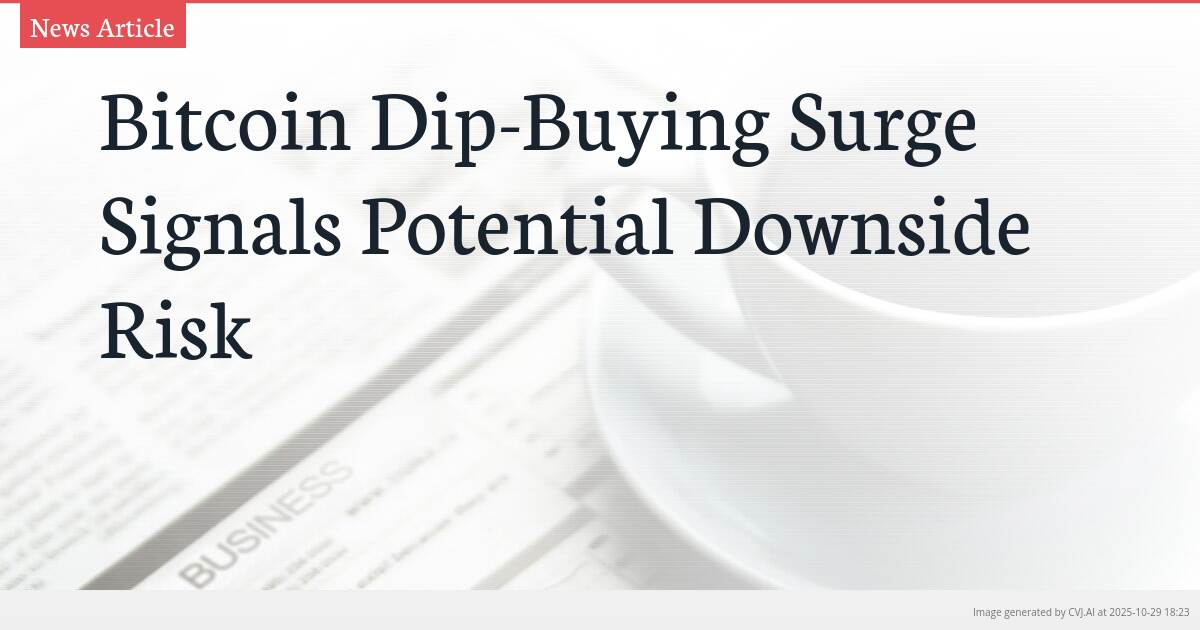This summary text is fully AI-generated and may therefore contain errors or be incomplete.
Introduction
Retail traders are rushing to buy Bitcoin’s recent dip from above $115,000 to $113,000, but historical data suggests this enthusiasm could backfire. Multiple technical indicators and macroeconomic factors point to potential further downside ahead as market sentiment clashes with bearish signals from both on-chain analysis and traditional financial markets.
Key Points
- Santiment data shows retail dip-buying enthusiasm has historically led to further price declines rather than quick recoveries
- TD Sequential indicator flashes sell signal after accurately predicting Bitcoin's last five major price movements
- Analyst warns Fed policy shift doesn't mean quantitative easing, with repo market liquidity stress worse than 2019 levels
Historical Patterns Warn Against Dip-Buying Enthusiasm
According to data analytics firm Santiment, retail traders have become increasingly vocal about buying the dip following Tuesday’s modest market pullback. This surge in enthusiasm for purchasing Bitcoin at perceived discounts has historically proven to be a contrarian indicator rather than a signal for imminent recovery. Santiment’s analysis reveals that in previous market cycles, the most profitable entry points typically occurred when retail sentiment was low and few participants expected a recovery.
The firm warns that traders often misjudge market bottoms, with initial optimism quickly turning to fear once prices continue their downward trajectory. True accumulation phases, according to Santiment, typically only emerge after this psychological shift from FOMO (Fear Of Missing Out) to FUD (Fear, Uncertainty, and Doubt) occurs. This transition period, marked by widespread pessimism, has historically preceded stronger and more sustainable market rallies, suggesting current retail enthusiasm may be premature.
Technical Indicators Flash Bearish Signals
Adding to the cautious outlook, crypto analyst Ali Martinez has highlighted that the TD Sequential indicator, known for accurately predicting Bitcoin’s recent price movements, has once again flashed a sell signal. This technical tool has demonstrated remarkable precision over the past several months, correctly forecasting a 7% correction in July, a 13% drop in August, a 10% rebound in early September, a 15% rally later that month, and a 19% correction in early October.
The consistency of the TD Sequential’s predictions lends credibility to its current bearish signal. Martinez’s observation suggests that Bitcoin could be preparing for another short-term downturn if historical patterns hold true. The indicator’s track record of accurately calling both upward and downward movements throughout the recent volatile period underscores its reliability as a market timing tool in the current environment.
Macroeconomic Headwinds and Liquidity Concerns
Beyond technical analysis, broader macroeconomic factors present additional challenges for Bitcoin’s near-term prospects. Analyst Doctor Profit has delivered a bearish outlook that contradicts market expectations surrounding Federal Reserve policy. While many market participants anticipate a 25-basis-point rate cut from the Federal Open Market Committee (FOMC), Doctor Profit argues that the real market impact will come from Federal Reserve Chair Jerome Powell’s accompanying remarks.
Doctor Profit contends that there’s widespread misunderstanding of the current policy shift, emphasizing that ending Quantitative Tightening (QT) does not signal the beginning of Quantitative Easing (QE). He maintains that liquidity conditions remain tight, with banks facing funding shortages and central banks merely stabilizing a fragile financial system rather than injecting new money. According to his analysis, the Federal Reserve will not resume QE unless a major crisis forces renewed money printing.
The analyst points to deepening liquidity stress in the repo market, describing it as worse than the 2019 episode, with overnight funding collapsing and cash availability drying up. Against this backdrop, Doctor Profit remains firmly short on both Bitcoin and traditional stocks, expecting market euphoria to fade and liquidity conditions to deteriorate further until the next systemic break triggers Federal Reserve intervention. This macroeconomic perspective suggests that current dip-buying optimism may be overlooking fundamental liquidity constraints that could pressure risk assets in the coming months.
📎 Read the original article on cryptopotato.com

